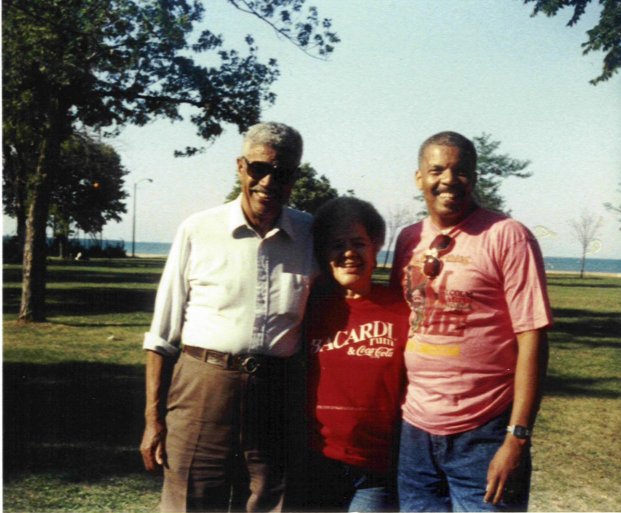
Herbie Hancock (born 1940)
Pianist, Composer, and Bandleader.

Herbie Hancock's Dad on a picnic with Gerri Oliver
and Gerri's cousin.

Herbie Hancock
See: http://afgen.com/herb.html
Herbie Hancock was born April 12, 1940, in Chicago, Illinois, into a musical household. His musical training began with the study of the piano at age 7. Evidence of Hancock's musical prowess appeared took little time to emerge; he gave his first public performance two years after beginning and by 11 he had performed Mozart's D Major Piano Concerto with the Chicago Symphony. Although during his early years Hancock was encouraged by his parents to listen to classical music, his interest turned to jazz in his high school years. Also, in high school Hancock's interest in electronics emerged and he decided to attend Grinnel College and Major in electrical engineering, but in his second year of college, he changed his major to music.
After graduating from college, Hancock, age 20, went to New York with trumpeter Donald Byrd who heard him play in Chicago. While in New York Byrd introduced Hancock to Blue Note Records executives. This led to work with various established jazz artists and later Hancock's his first solo album, Taking Off, which included appearances by Freddie Hubbard and Dexter Gordan. Contained on this album was Hancock's first top 10 hit Watermelon Man. It was not long before Hancock got the attention of the legendary Miles Davis, who extended an invitation to Hancock to join his new group.
Stereo Receivers While working with Miles, Hancock was introduced to and developed an interest in funk, particularly James Brown and Sly Stone. Hancock himself cites Sly Stone'>s Thank You Falletinme be Mice Elf Agin, " That song elated me . It is so raw and primitive I don't know how it could be created. I touched my soul and heart, and immediately got me to create some funky music myself" (Down Beat 53:18). After working with Davis for several years Herbie decided to form his own band, a sextet which included Julian Priester, Buster Williams, and Eddie Henderson.
With this group Hancock began to pioneer what would later be called fusion as he, through his original compositions, melded ideas of funk and rock with jazz. Hancock took this opportunity to introduce himself to synthesizers. Headhunters (1973) was the first album on which Hancock used a synthesizer. Up to that point his work was acoustic with the exception of a Rhodes Electric Piano. Hancock purchased his first synthesizer, an Arp String Ensemble, the same year he made Headhunters and incorporated it into the album. The album, which became the largest-selling jazz album in history contained "Chameleon," another of Hancock's crossover hits. Incorporating synthesizers at this pace was mitigated by Hancock's experience with electronics and aptitude for the subject. After a few years, Hancock returned to his roots as an acoustic pianist with the V.S.O.P. Quintet, a recreation of Miles' band (without Miles), and several other Jazz Artists.
1983 brought Future Shock, which was both a pioneer electronic piece but also a hit on both R&B and dance charts. Future Shock stands out among computer-based pieces because Hancock managed to explore several electronic devices and gain mass appeal: "Rock It" won him a Grammy for best R&B Instrumental.
Even after Future Shock Herbie has continued to explore many facets of entertainment including film scores and acting. At age 55 Hancock recently released Dis is Da Drum and continues to dazzle the entertainment world with his talent.